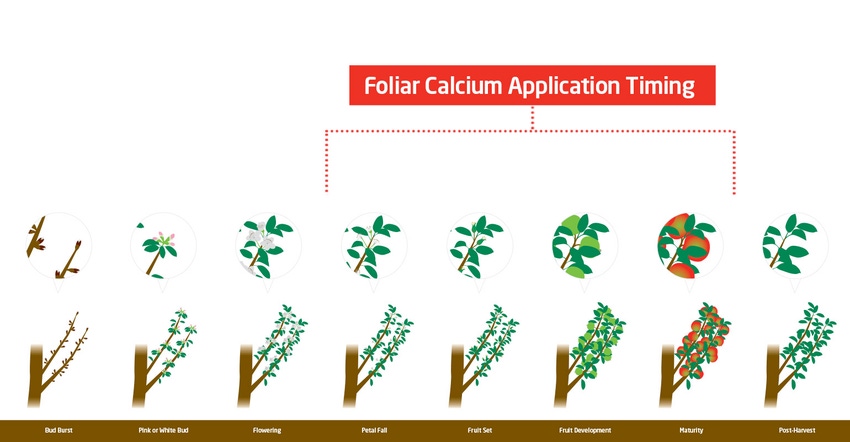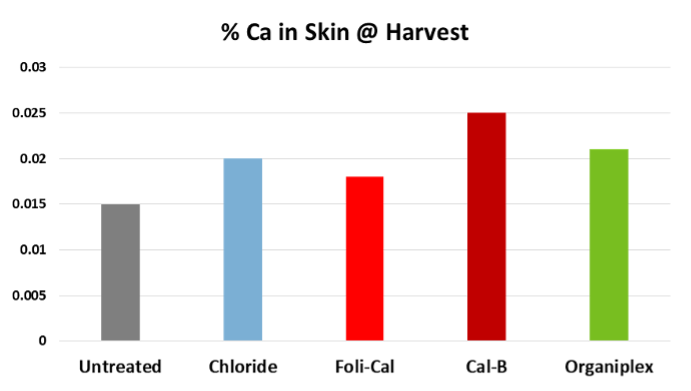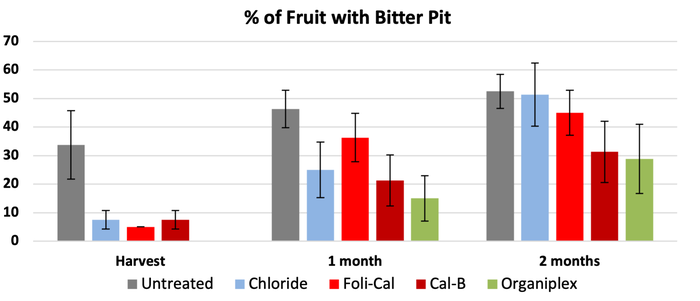May 10, 2021

Sponsored Content
Agronomics / Background
Fruit calcium (Ca) level is one of the most important factors relating to fruit quality in apple production. Ca plays a critical structural role in the formation and stability of both cell walls and cell membranes. Bitter pit is a physiological disorder that occurs in apple fruit when there is a localized deficiency of Ca within the fruit. Symptoms typically show up first near the calyx end of the fruit where Ca levels tend to be lowest. These necrotic lesions are believed to be due to the breakdown of the fruit cell membranes within these low Ca parts of the fruit. High fruit Ca levels will also lead to better fruit firmness at harvest and better pack out rates coming out of controlled atmosphere facilities. This is due to Ca's role in strengthening cell walls and reducing the activity of enzymes that breakdown pectins in the fruit.
Conditions Leading to Ca Deficiencies
Ca related fruit disorders occur due to the lack of mobility of Ca within the plant. Early in fruit development, Ca moves through the xylem directly from the soil into the fruit. Excess early season vegetative growth due to high nitrogen (N) levels can lead to an imbalance of too much Ca going to the leaves and not enough into the fruit. Low soil moisture and/or high heat will also diminish Ca uptake from the soil. As the fruit gets larger, the xylem delivery into the fruit is cut off and only the phloem supplies the fruit. Ca is completely immobile in the phloem so from this point forward only foliar Ca applications that directly contact the fruit will increase fruit Ca levels. High fruit ratios of potassium (K) and magnesium (Mg) to Ca have been shown to increase risk of bitter pit. In highly susceptible varieties such as `Honeycrisp', late season applications of Mg and K should be moderated or eliminated.
Desired Ca Tissue Test Values
During the summer, leaf Ca levels should be around 1.5-2.0%. However, this may not be a good indicator of how much Ca actually got into the fruit. Analyzing fruit Ca levels can be helpful in predicting Ca related disorders, but it varies between varieties. It is much more reliable to examine past effects of cultural and fertility practices on actual fruit quality parameters like firmness and bitter pit levels.
Key Application Timings and Rates
Foliar Ca applications can begin as early as petal fall. Early applications may be especially advantageous if conditions for soil uptake are impaired or if there is excess early season shoot growth. Most cultivars should receive at least 5-6 foliar applications. For more Ca sensitive varieties, 12 or more sprays may be needed, spaced out throughout the fruit sizing period in order to maintain adequate fruit Ca concentration as the fruit get larger.
BRANDT Foliar Calcium Technology
BRANDT has several highly effective foliar Ca formulations. BRANDT® Manni-Plex® is a foliar nutrient line formulated with sugar alcohol complexes. BRANDT® Organiplex™ is an OMRI-Listed foliar nutrient line formulated with amino acid complexed nutrients. Both product lines are formulated to ensure that nutrient applications get into the leaves and fruit tissue.
Key calcium formulations in these product lines include:
· BRANDT® Organiplex® 8% Ca
· BRANDT® Manni-Plex® Foli-Cal®
· BRANDT® Manni-Plex® Cal Zn
· BRANDT® Manni-Plex® Cal Mag
· BRANDT® Manni-Plex® Cal-B
These products perform well at 1-2 quarts per acre.

Trial Data


Calcium Trial on Honeycrisp Apples conducted in Oregon City, OR in 2020
*Source: BRANDT Field Trials 2020
BRANDT products are available at ag retailers and dealers through the U.S., America’s, Europe, Africa and Asia. To learn more, visit www.brandt.co or download BRANDT’s free product finder app for Apple and Android devices. To sign up to receive BRANDT news and information, email [email protected] and follow us on Facebook @BRANDTProAg and Twitter @BRANDT_co .
About the Author(s)
You May Also Like




